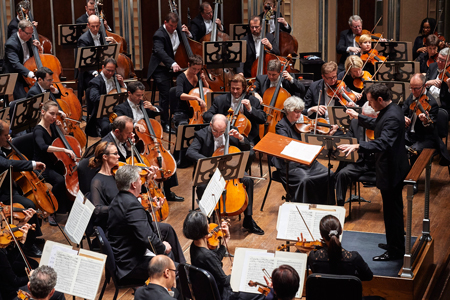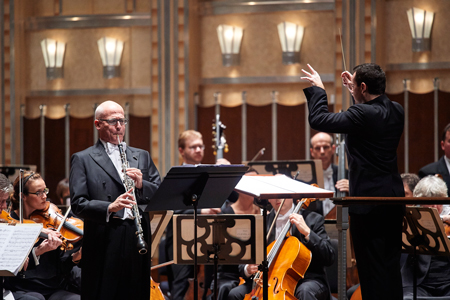by Nicholas Jones

Berlioz’s symphonic outpouring about love and obsession is a perfect match with the virtuosity of The Cleveland Orchestra and the acoustics of Severance Hall. Berlioz went all out in the orchestration: two harps, two tubas (actually, in the original, two ophicleides, if anybody’s ever heard of those), two sets of timpani, four bassoons, and as many string players as he could muster.
If the brass dominate the feverish ending of the Berlioz (witches! a guillotine! an opium dream!), in the first movement, the strings set the stage for this extended Romantic tragedy. The Cleveland Orchestra’s string players — clear in tone and dazzling in intonation — engaged the audience almost instantly in the “flux of passion” that Berlioz calls for.
The orchestra’s extraordinary wind players took the vicissitudes of that passion even further, with sardonic riffs in the clarinets contrasting with lyrical ensembles among the principal oboe, flute, and bassoon. The pastoral interlude in the third movement featured the English horn (Robert Walters — more about him below) in a moving dialog with the offstage oboe, played by principal Frank Rosenwein.
The percussion drove the rhythm throughout the work. The sound of the drumbeats that lead the symphony’s hero to the scaffold remains unmistakably modern, even today. (Imagine hearing it only a generation after Beethoven!)
French conductor Lionel Bringuier managed Berlioz’s grand mayhem with grace and evident pleasure. A protegé of Gustavo Dudamel at the Los Angeles Philharmonic, and now music director of the Zürich Tonhalle Orchestra, Bringuier excelled in evoking mood and color in the Impressionist tradition, reveling in Berlioz’s radical orchestrations. There were some ragged entries, where the more precise gestures of his mentor would have been welcome. But overall, it was a joy to hear this inspiring young interpreter in his signature piece (the Berlioz was the keynote of Bringuier’s first program last year in Zürich).
The Berlioz fittingly ended the evening. Before intermission, Robert Walters, the orchestra’s principal English horn, was the elegant and forceful soloist in the world premiere of Bernard Rands’ Concerto for English Horn. The concerto was commissioned by the Oberlin Conservatory of Music in commemoration of its 150th anniversary and in honor of Walters’ service as Professor of Oboe and English Horn at Oberlin.
The soloistic opportunities for English horn virtuosi are few and far between, and an addition to that instrument’s solo repertoire from the distinguished British-born composer is no small matter. Even more significant is the high quality of the writing in this concerto: accessible and challenging at the same time, it has a melodiousness as well as an energetic, even throbbing intensity.
Rands’ concerto is in three movements, the first a “Fantasia” with swirling and agile lines and a series of powerful interactions between the soloist and other low-registered instruments, including bassoon, bass clarinet, trombone, and tuba.
In the second movement (“Aubade” or dawn-song), Rands evokes the long history of the English horn as a pastoral instrument (as, indeed, in the Symphonie fantastique). Rands’ skillful orchestration supports the soloist with a rich instrumental accompaniment (for example, a shimmering high string sound).
The third and final movement of the concerto is dedicated to the memory of the composer Claude Debussy, and in its mediation of sylvan playfulness and erotic intensity, it made for a primal excitement that well matched Debussy’s Impressionist spirit. Walters projected his solo lines with masterful roulades across the entire range of his instrument, and with forceful, even gymnastic accents.
The concert began with a lush performance of Debussy’s Prelude to the Afternoon of a Faun. Principal flute Joshua Smith opened the piece with a sexy evocation of the faun’s languorous desires. The rising passions of Debussy’s fantasia grew almost imperceptibly from that quiet beginning, with solo oboe, violin, and cello adding to the sense of a deeply-felt sensuousness. Bringuier conducted the chamber-sized orchestra with care to keep the arc of increasingly complex sounds from becoming too overbearing.
With delicacy and restraint, the Debussy introduced the themes of dream, fantasy, and desire that, by the end of the evening, were to find much grander realization in Berlioz’s sonic extravaganza. Congratulations to the orchestra for its smart programming, placing these very different yet parallel works, both classics, as bookends to Bernard Rands’ brand-new contribution to the canon.
Photos by Roger Mastroianni courtesy of The Cleveland Orchestra.
Published on ClevelandClassical.com December 1, 2015.
Click here for a printable copy of this article





